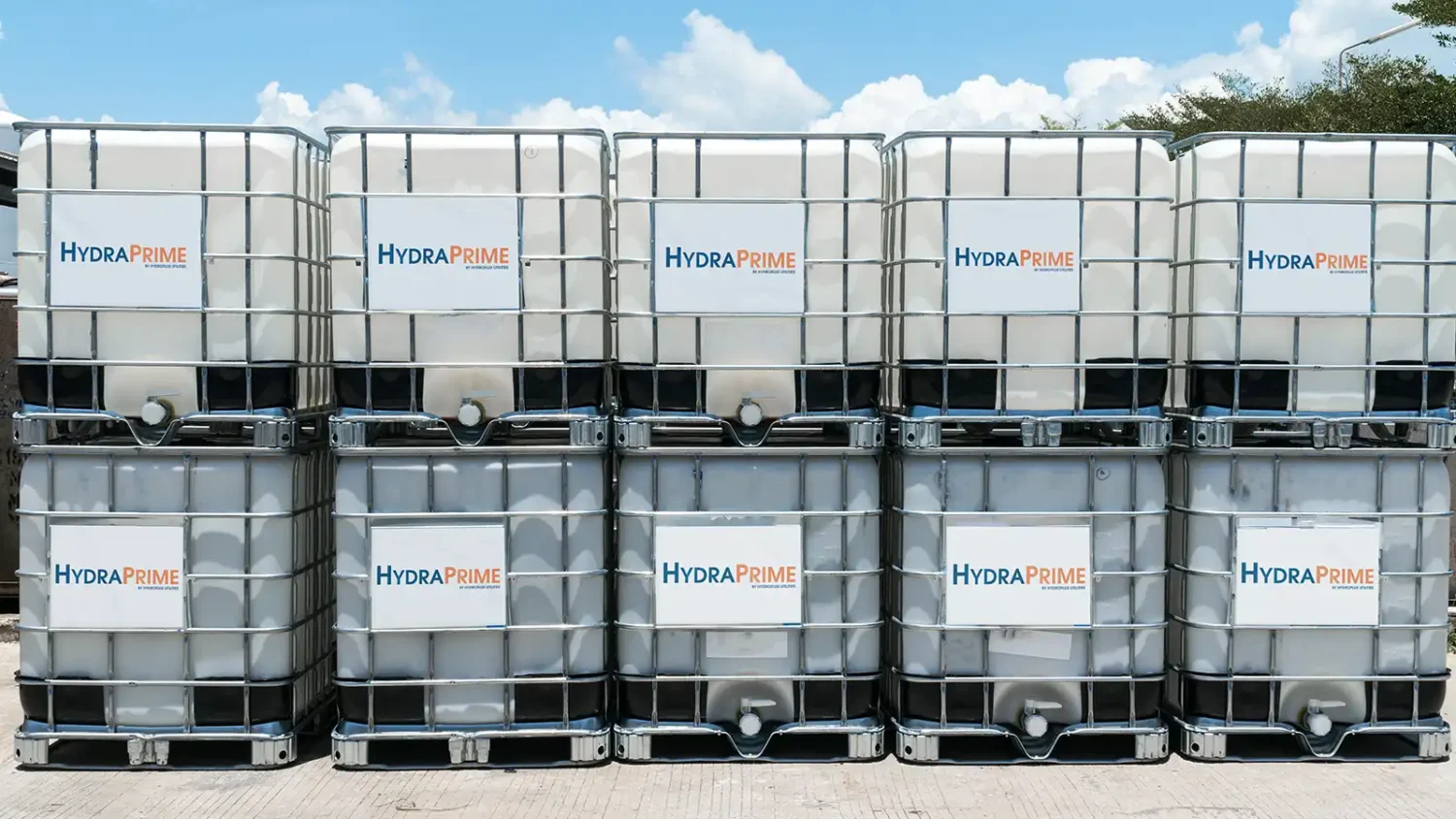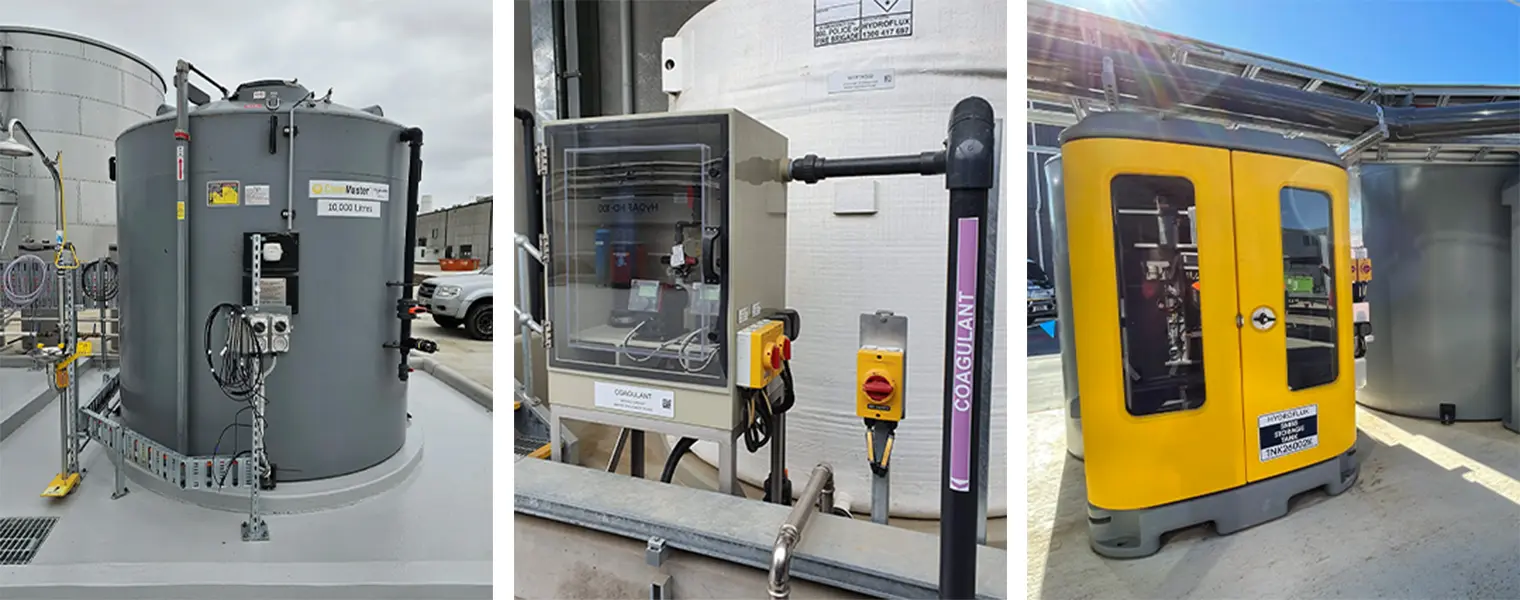
HydraPRIME® Coagulant Series

Hydroflux Utilities HydraPRIME® coagulant chemicals for water and wastewater treatment offer a full range of proprietary and blended multifunctional inorganic and organic coagulants designed exclusively for the optimised treatment of water and wastewater. HydraPRIME coagulants meet diverse applications to ensure operational excellence and cost efficiency.
Why choose Hydroflux Utilities as your Coagulant Supplier?
Using the right coagulant in your water or wastewater treatment operations will not only enhance performance but also reduce the total operational costs of your water and wastewater assets. With our comprehensive range of coagulants and industry-leading application knowledge, you can have confidence that you’ll receive the right coagulant that meets your treatment plant objectives, guaranteeing cost-effectiveness, and optimising overall operational efficiency all whilst meeting business sustainability objectives.
HydraPRIME® Coagulants play an Essential role in Water and Wastewater Treatment
Each water and wastewater stream is unique, as is the equipment used for treatment, making every coagulation program distinct. Coagulant chemicals for water treatment are crucial for water and wastewater clarification. By leveraging Hydroflux Utilities’ expertise in coagulation processes, businesses can find cost-effective solutions. Often, these solutions are realised in a short period of time. Regardless of your specific needs, Hydroflux Utilities commits to thoroughly understanding your processes. We deliver the most effective coagulant and the best overall solution for your applications. Some of the coagulants used for various common applications are listed below.
- Particle Aggregation: Transforming suspended colloidal particles into larger flocs that settle or float more rapidly.
- Enhanced Filtration: Preventing filter clogs and maintaining system efficiency.
- Organic Removal: Reducing BOD and COD levels by facilitating organic compound adsorption onto flocs.
- Nutrient Control: Assisting in phosphorus precipitation and protein encapsulation for effective nutrient removal.
- Visual Improvements: Significantly diminishing water turbidity and colour for a clearer, more aesthetically pleasing output.

Hydroflux Utilities is more than just a chemical supplier
Hydroflux Utilities goes beyond being just a chemical supplier; we become your trusted advisor.
When engaged in a chemical supply contract, we schedule free regular site visits where Hydroflux professionals discuss plant performance, chemical usage, and sludge generation, and offer professional advice for further optimisation, ensuring continuous improvement in your wastewater treatment processes.
Efficient national chemical supply chain
Whether you are purchasing HydraPRIME in pales, IBCs, or bulk, Hydroflux has dedicated logistics teams that ensure a streamlined supply of chemicals to customers from our warehouses. With well-established supply chains, chemicals are delivered to your site seamlessly and on time, minimising disruptions to your operations.
We also rent chemical dosing systems
Renting HydraPRIME chemical dosing equipment allows you to access the latest technology without the high upfront costs and long-term commitment of purchasing. Whether you need temporary solutions for seasonal demands, emergency situations, or trial periods before investing in permanent systems, renting can provide the adaptability and support necessary to ensure optimal performance of your process operations.
Click here to visit our Rentals page.
Sustainable Solutions
As Australia’s first certified carbon-neutral water and wastewater chemical supply and service business, developing and delivering sustainable solutions for treatment plant operation and maintenance is at the core of what we do. Our HydraPRIME coagulants are the most sustainable in the Australian and New Zealand market. They are not just effective at protecting our valuable water resources, but are also carbon-neutral. Click here to find out what this means for you.

Want to Know More?
Watch our Coagulation fundamentals video which includes details on:
- What is Coagulation and why it is important?
- The mechanisms of Coagulation.
- Organic vs Inorganic Coagulants.
- What happens if we overdose on a Coagulant?
- Effect of pH on Coagulants.
Coagulant FAQs
Coagulants and flocculants are both used in water and wastewater treatment to remove suspended particles, but they serve different functions. Depending on the type of coagulant (organic or inorganic), and depending on the operating pH, coagulants can work by either charge neutralisation, sweep flocculation or chemical bridging, and sometimes via a combination of these mechanisms.
Whatever the mechanism, the idea is to cause very tiny particles to come together to form microflocs. Common coagulants include aluminium sulphate and ferric chloride. Flocculants, on the other hand, help these microflocs aggregate into larger flocs that can be more easily removed from the water. They often consist of natural or synthetic polymers, such as polyacrylamides. While coagulation is typically the first step in the treatment process, flocculation follows to enhance the formation of larger flocs.
Yes it does! The type and dosage of chemicals, such as coagulants and flocculants, influence the characteristics of the sludge, including its volume, density, and dewaterability. Effective chemical treatment can enhance the aggregation of suspended particles, resulting in a more compact and settleable or floatable sludge depending on whether you are using clarification or flotation technology for solids removal, which is easier to handle and dewater. Conversely, improper chemical dosing or selection can lead to excessive sludge production or poor sludge quality, complicating its management and disposal. Optimising the wastewater treatment chemical treatment program is crucial for optimum treatment and efficient sludge handling and minimising overall operational costs.
In wastewater treatment, common coagulants used include aluminium-based compounds like aluminium sulphate (alum) and polyaluminum chloride, as well as iron-based compounds such as ferric chloride and ferric sulphate. These coagulants can work via charge neutralisation and/or sweep flocculation, although usually they work via sweep flocculation due to the operating pH of most wastewater systems (i.e. pH > 5). The coagulation process allows the particles to clump together and form larger aggregates or flocs, which can then be more easily removed through sedimentation, flotation, or filtration processes. The choice of coagulant depends on factors such as the specific contaminants present, the pH of the water, and the desired treatment outcomes. Additionally, synthetic organic polymers, such as polyamines and polyDADMAC that work specifically via charge neutralisation, are sometimes used as coagulants to enhance performance and reduce the required dosage of inorganic chemicals.
Yes, while most coagulants will work at almost any pH – they each have an optimum pH range where they work best. Aluminum-based coagulants like aluminum sulphate (alum) are most effective in a pH range of 5.5 to 7.5, while polyaluminum chloride (PAC) can work well in a broader range from 5.0 to 8.5. Iron-based coagulants such as ferric chloride and ferric sulfate typically perform best in acidic conditions, with optimal pH ranges from 4.0 to 6.0, though ferric chloride can be effective up to a pH of 8.5. Organic coagulants like polyamines and polyDADMAC are versatile and can operate over a wider pH range, often from 4.0 to 10.0. Usually pH adjustment of the water is necessary to achieve optimal coagulation performance, taking into account the specific contaminants and overall water chemistry.
The Hydroflux Group
Hydroflux Utilities, being part of the Hydroflux Group has access to extensive expertise in water and wastewater treatment processes, mechanical and electrical design, programming and turnkey construction. By leveraging the collective knowledge and resources of the Hydroflux Group, Hydroflux Utilities ensures that you receive high-quality, innovative solutions that meet your specific needs and deliver sustainable results for your water, wastewater or sludge treatment processes.
